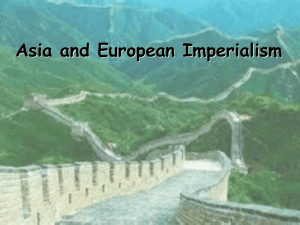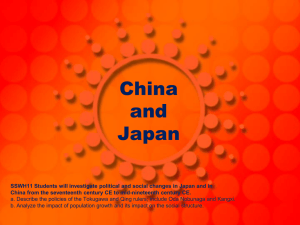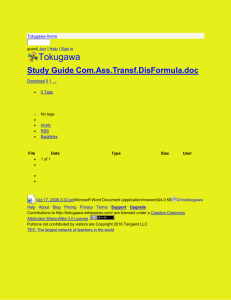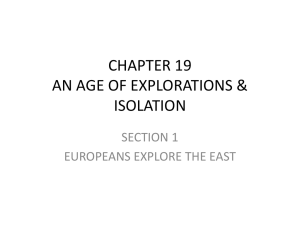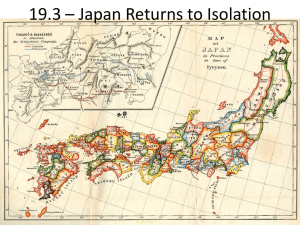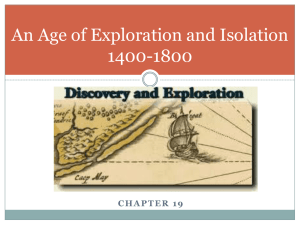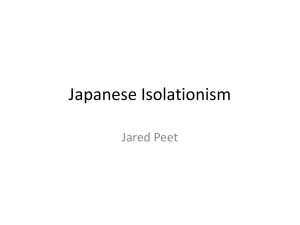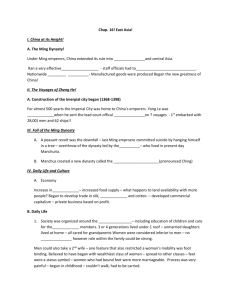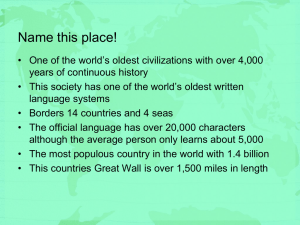Click here to get the file
advertisement
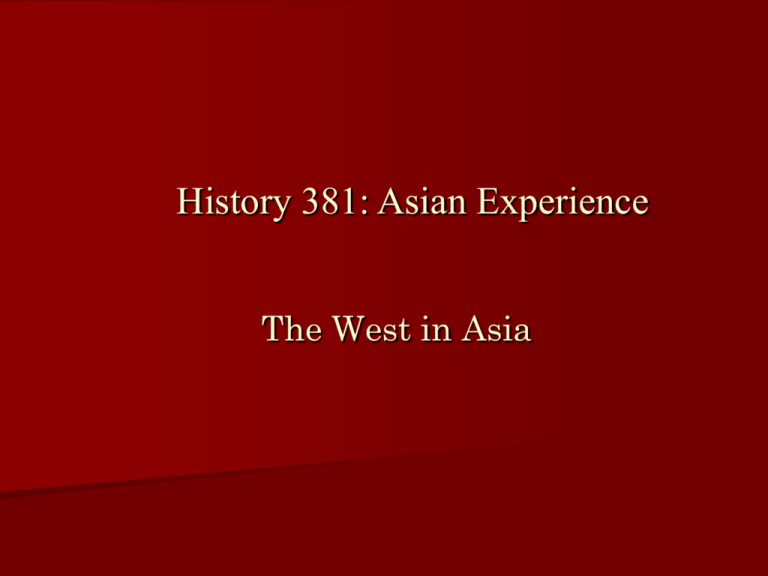
History 381: Asian Experience The West in Asia The West Arrives in Asia Independent Development • Relative value and awareness of trade networks in classical Europe, the Arabic peninsula, and Monsoon Asia The Portuguese in Asia • Columbus; Portugal and the open seas • Portuguese shipbuilding and navigation • Naval warfare Motives for Expansion • Western views of Muslims as the “enemy” • Middle Eastern control of trade; Henry the Navigator – Voyages of Exploration Portuguese explorers; the influence of Marco Polo; early Portuguese contacts with India – The Portuguese Commercial Empire The Portuguese in Goa; Portuguese military dominance at sea; Magellen; the colonies of Spain and Portugal; Asian women and Western men The Spanish in the Philippines • The flow of silver to Asia, New World crops • loose Spanish control in the Philippines • missionary work Trading Bases in Asia • African bases along the sea routes to Asia; Europe’s limited role in the spice trade; European traders working Asian markets; Europeans on the periphery; Portuguese and the rest of the commercial network along the sea lanes; the rise of Dutch and British influence and decline of Portuguese control; the legacy of Portugal “Christians and Spices” • The Spanish and Portuguese missionary thrust; the slaughter of Asian “heathens”; Albuquerque; the Counter-Reformation in Europe and the Jesuits in Asia; the Guangzhou trade Matteo Ricci: Mission to the Ming Court • Ricci’s background; an accomplished man of learning; his move north to Beijing and acceptance at court; the adaptation of Ricci’s message to China; Chinese interest in Western science and technology; controversy and expulsion; feedback and renewed Western interest in China The Russian Advance in Asia • Russian advances into Siberia; Chinese-Russian clashes; the Treaty of Nerchinsk (1689); Chinese disdain for the “sea barbarians” and high regard for the Russians Japan’s Christian Century • Japanese curiosity and acceptance of Western things; inter-Christian contentions and governmental concern; persecution; the limits of foreign control; minimal European impact and success; European dominance at sea; the uncivilized nature of European sailors; Asian disinterest in Europe The Dutch in Asia • The Dutch challenge to Portuguese dominance in Asia; van Linschoten and Dutch expeditions to Asia; Dutch victories; Dutch interest in trade; The Dutch East India Company and its monopoly of the Asian trade; the Dutch Indies and Holland’s sphere of influence; Coen in Batavia (Jakarta); harsh dealings with rivals and lawbreakers; the slow rise of Dutch administration; Dutch regulation and manipulation of production The English in Seventeenth-Century India • Thomas Best and the defeat of the Portuguese • Portuguese Jesuit intrigue against the English at court • Mughal cooperation • Roe and English interest in Bengal The Ming Dynasty 1368-1644 Ming Dynasty (1368-1644) – Founded by Zhu Yuanzhang who overthrew Mongols – Inaugurated new era of greatness in china – Extended rule over Mongolia and Central Asia – Strengthened Great Wall – Korea made tributary – Returned to traditional Confucian institutions Six ministries at top Civil service exams Divide empire into provinces, districts, counties – Population had doubled Scholars taking the civil service exam The civil service examinations of the Qing dynasty tested candidates’ knowledge of the Confucian canon: rituals, history, poetry, cosmology--all believed to provide the basis for a moral life-and calligraphy. By the eighteenth century, the system was under attack because it failed to select the ablest scholars, the number of candidates had not increased in proportion to population, degrees were sold to the rich, and frequently even successful candidates could not find positions. The Great Wall north of Beijing ©2004 Wadsworth, a division of Thomson Learning, Inc. Thomson Learning™ is a trademark used herein under license. China at its Apex Zhenghe – Chinese admiral. – In 1405 led fleet of ships into Indian Ocean. – Large fleet with 28,000 sailors. – Sent to find information as well as goods. – Brought increase in knowledge of outside world. – Brought massive profits. – Voyages ended with death of Emperor Yongle (1402-1424) who had sent them. – Marks turning inward of China and focus on agriculture. Navigation techniques of Zheng-He The navigational techniques that Zheng He and his crew used were well established and tested, as this manual Wubei zhi (records of military preparations), 1621, shows. Ships were precisely guided by reference to the Pole Star, and the routes to India, the Middle East, and East Africa were well known. The manual underscores that Zheng He's mission was not to explore but to carry out political and, if possible, economic mandates. First Contacts with the West China’s view of Europeans Portuguese arrival, 1514, Macao – Problems with the Portuguese – Portuguese and trade Jesuit missionaries – Parallels between Christian and Confucian concepts First Contacts with the West Jesuit missionaries – Brought ideas into China – Highly educated – Tried to draw parallels between Christian and Confucian concepts – Reported back on China to Europe which sparked curiosity Ming Brought to Earth Decline in the 16th century due to a series of weak rulers Internal problems – Economic Inflation from foreign silver English and Dutch disrupted silver trade – Agricultural Crop yields fall with “little ice age” Frontier – Manchus Peasant revolt led by Li Zicheng (Li Tzu-ch’eng, 1604-1651) – Occupied Beijing in 1644 – Manchus conquer Beijing and create new dynasty with the name Qing (Ch’ing, or Pure) The Greatness of the Qing (1644-1911) Chinese to adopt Manchu dress and hairstyles Manchus adopt Chinese conditions Kangxi (1661-1722) – Greatest ruler in Chinese history probably – Gained throne at age 7 – He was diligent, politically astute and strong character – Ruled for sixty years – Quieted northwestern frontier – Made dynasty acceptable to population – Patron of arts – Tolerant toward Christians and allowed missionaries The Greatness of the Qing Qing Politics – Retained Ming political system – Devotion to the principles of Confucianism – Manchus made only 2 percent of the population Manchu nobles’ privileges Bannermen Ethnic Chinese cannot settle in Manchuria The Qing Empire The Qing dynasty from 1644 to 1912 generally continued the political and social order of the previous Ming dynasty. China on the Eve of the Western Onslaught Corruption – White Lotus Rebellion, 1796-1804 Russian traders in Manchuria – Refused tributary status – Treaty of Nerchinsk, 1689 England replaced Portugal as the dominant European trader in Asia – First trading post at Canton, 1699 – Qing licensed Chinese traders – Large amounts of silver to pay for Chinese goods – Mission under Lord Macartney, 1793 failed in negotiating with China the British requests to: the relaxation of the restrictions on trade between Britain and China the acquisition by Britain of "a small unfortified island near Chusan for the residence of English traders, storage of goods, and outfitting of ships" the establishment of a permanent British embassy in Beijing Qianlong Emperor at Archery Contest During the sixty-year reign of the Qianlong emperor, China became the world's richest and most populous nation. Executed by the Italian Jesuit Giuseppe Castiglione, whose portraits and panoramas combine Chinese composition with Western perspective and coloration, this painting of the emperor at an archery contest--with elegant garden, stately uniforms of the attendants, and dignified image of the emperor--suggests the formal ritual of the imperial court. Castiglione was a special favorite of the emperor, who also supported Jesuit architects and designers. Canton Canton (modern Guangzhou) – Chinese limited European trading to this city – Emperor licensed a few Chinese companies to handle all of the trade – Eventually confined Europeans to island just outside the city – Europeans could only reside there part of the year – This system of limiting trade came to be known as the “Canton System” Daily Life in Qing China The family – Center of society was joint family where 3 or 4 generations lived together – Sons brought wives to live with family – Not always enough land to support large families however – Labor intensive agricultural society needed large families for labor – Sons very prized – Oldest male was head of family – Arranged marriages – Father expected to provide for family and treat them with respect and compassion Tokugawa Japan Tokugawa Japan Japan’s Basic Geography The Land: – 4 main islands: Hokkaido, Honshu, Shikoku, Kyushu – Some 1000 small islands in the Pacific – 145,834 square miles (the size of Montana) – 72% of it is of hills and mountains, 20% land arable, with a population of 123 million The Climate: – Two weather systems: Monsoon air & Japan Current from the south Siberia air & Okhotsk Current from the north – Most populous area around Yamato plain: 35 parallel where four seasons are distinct, with 215 growing days & plenty rainfall Rice Culture & Mainland Connection Rice as main staple food: 55% of cereal acreage is rice paddies, labor intensive & group identity Seafood as main source for protein: sushi as typical Japanese food Two main plains: Kanto (Tokyo) & Kinai /Yamato (Kyoto, Osaka) Tsushima Strait: 115 miles to Korea (Dover, 21 miles) – The “borrowing culture” Environment and Psyche 500 plus volcanoes, which produce 1500 earthquakes per year – Cause: submarine trench of 6 miles below water & mountains of 2 miles above water – 21 major earthquakes since 1596 (above 1000 casualties in each) Typhoons from the ocean The psychological impact: attitude toward nature, death, and each other -> Shintoism Shintoism Shintoism is a Japanese religion that came from the indigenous people of the country. Beginning in the late fourth century B.C. It has no founder or doctrine. The beliefs of this religion center on being one with nature. Members of the Shinto belief worship the kami, who include native deities (including emperors and heroes), spirits of nature, and mythical objects. Tokugawa Japan The Three Great Unifiers – Oda Nobunaga (1568-1582) – Toyotomi Hideyoshi (1582-1598) – Tokugawa Ieyasu (1598-1616) Tokugawa Japan Oda Nobunaga (1568-1582) – Son of a samurai and military commander – Seized capital at Kyoto and put shogun under his control – Brutal, he planned to put all of central plains under his control – Killed by one of his generals in 1582 Tokugawa Japan Toyotomi Hideyoshi (1582-1598) – Farmer's son who worked way up through ranks – Capital at Osaka and slowly extended power outward – By 1590 most of daimyo accepted his authority – Created national currency – Still had to work with local daimyos – Carried out sword hunts to remove arms from countryside – In 1587 banished Christianity from his domains, although later relented Tokugawa Japan Tokugawa Ieyasu (1598-1616) – Daimyo of Edo which is modern Tokyo – Filled leadership vacuum after Hideyoshi's death – Claimed title of shogun in 1603 – Created longest lasting of the shogunates (to 1868) – Completed centralization of authority – 1612 evicted all missionaries The Tokugawa “Great Peace” Ruled through a coalition of daimyo (great lord) and a council of elders State divided into territories, han Social system – Changes with samurai system (warrior class) Samurai – Became less important under Tokugawa shogunate – Daimyo protected own interests by depriving many samurai of land rights – Many became salaried officials – Those who tilled the land reclassified as commoners – Could still wear swords – Ceased to be a warrior class and many lived in towns – Often did not make enough revenue from rice lands, so fell into debt – Others released from servitude to lord and became “masterless” Samurai (Ronin) Sometimes plotted against officials Tokugawa Japan Opening to the West – Portuguese arrive in 1543, begin trading – Visitors welcome at first, but later are suspected of political interference – Portuguese Jesuits Francis Xavier – Spanish Franciscans – Expulsion of all missionaries – Prohibited foreign trade – Dutch at island of Hirado at Nagasaki Tokugawa Japan Nagasaki harbor – After 1612 only remaining location open to Europeans – Small Dutch community permitted to engage in limited trade – Ships could dock once a year and inspection could remain for 2-3 months Seeds of Capitalism Bakufu – Coalition of daimyo and council of elders – Tokugawa ruled through it – Set national policy on behalf of emperor – Shogun’s own domain included about onequarter of the nation as well as three big cities of Edo, Kyoto and Osaka – Nation divided into domains and ruled by daimyo – Daimyo forced to maintain two households and leave families at Edo as hostages – Size of samurai class limited Tokugawa Culture Status of women in Japan – Became somewhat more restricted under Tokugawa – Samurai class women very restricted Had to submit at pain of death – Males often took concubines or homosexual lovers – Females must remain chaste – Some became accomplished artists Tokugawa Culture Common women – Marriages arranged – Could be divorced by husband – More equal than in upper classes – Valued as childbearers – Both sexes worked in fields – Co-education in villages Korea: The Hermit Kingdom Followed the Chinese model Yangban (aristocratic class) Chonmin (slaves) Development of phonetic alphabet, hangul Growing economy Attempts to keep Korea isolated – Japanese invasion – Manchu invasion – Relatively untouched by Europeans Korea: The Hermit Kingdom Yi dynasty – Patterned after Chinese model – Founded by military commander Yi Song Gye in late fourteenth century – New capital at Seoul – Accepted tribute status with China – Adopted Chinese culture and systems – Used civil service exams – Restricted entry into bureaucracy Korea to 1900 Korean Culture Chonmin – Korean class of slaves – Worked on government plantations – Or served in certain occupations considered beneath dignity of other classes Korean Culture Hangul – Korean spoken language – In fifteenth century a phonetic alphabet was created for writing it – Used primarily as teaching device – Eventually became popular for publishing Confucianism And Christianity The premise of Confucian teachings is centered around the idea of Jen or the virtue of humanity. – To accomplish this, five relationships must be honored: ruler and minister father and son husband and wife elder and younger brother friend and friend Confucius felt that love and respect for authority was a key to a perfect society. Christianity also preaches a divine, brotherly love. Modern Christianity seeks to discover a rational understanding of the person as did Confucius.
